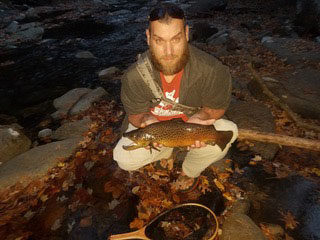To learn a new hobby, and be proficient in it, takes thousands of hours of practice. Fly-fishing is no different. Casting, drifting, fly selection, and reading water are all learned abilities. The more time you spend doing them, the more proficient you become. Many anglers, who fly fish, are under the assumption that there is a “magic fly” that catches fish, no matter the presentation. Don’t get me wrong, some days a certain fly will produce more fish, but that same fly produces more fish when presented properly.
In Western North Carolina, we can have many hatches at the same time. Sometimes, it can be very hard to narrow down exactly which bug fish are targeting. At other times, fish won’t be hitting the surface but the air will be filled with everything from mayflies to caddis. I remember a December, many years ago, when I was on the Upper Nantahala DH. I remember this evening, specifically, because of the Blue Wing Olive hatch I was witnessing. It was the biggest hatch I had ever seen. They were so thick, at times, that I couldn’t see my indicator. All during this hatch I was using a Y2K and catching fish after fish. It never occurred to me that I should change flies. Why would I? I was catching fish. Later, once I learned more, I begin to ponder why I had caught fish. If the hatch was so important, the fish should have ignored an attractor pattern and targeted what was hatching. That moment was when I really started studying fish behavior.
Fish behavior can be one of the most aggravating aspects of fishing. Water temperature, water flow, watercolor, food availability, and anglers are all factors that affect fish behavior. In a North Carolina Delayed Harvest, fish are stocked heavily. These fish have not experienced current before, let alone, seen a rock. They are extremely territorial and curious, usually trying to eat anything that comes their way. They prefer to sit on the bottom in pools where the water is calmer. This can present a problem when water flow is heavy. Faster flow can create cross-currents that can be very hard to read. Accurate casting, and mending your line properly, in these situations, can be the difference between catching and fishing.
Human influence has a huge impact on how a fishery can fish. Hard-fished water can be very daunting at times. The fish learn very quickly to avoid attractor patterns, and move to harder to drift runs. These streams demand accurate casting with no surface disturbance, proper mending, and almost flawless presentation…Might be one reason I stay off of the beaten path.
Most fish are opportunistic feeders. They will eat about anything that looks like food. I have caught vegetarian fish, on the fly, because of their curiosity. Fly-fishing, in general, is about presenting a fly as it would be presented in nature. I, personally, think that most people have forgotten this important aspect of fly-fishing. Until next time, tight lines and stable rocks!
Justin Mickens is Co-Owner and Manager of Appalachian Outfitters Fly Shop in Murphy, NC
